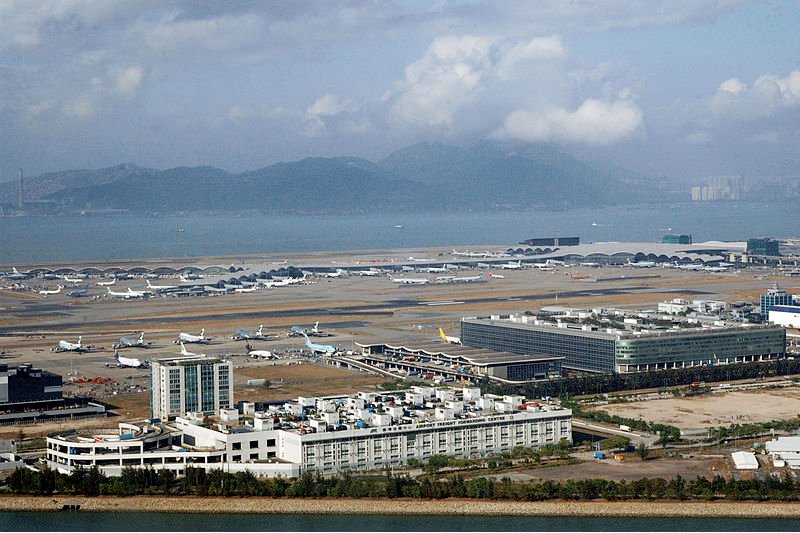 Hong Kong International Airport
Hong Kong International AirportSource: http://commons.wikimedia.org/wiki/File:Chek_Lap_Kok_Airport.jpg
Author: James Wheare

Hong Kong International Airport (HKG), also called the Chek Lap Kok Airport, is a mammoth facility that opened in June 1998 to replace the very crowded Kai Tak International Airport. It is located on the island of Chek Lap Kok, which is to the west of Hong Kong Island and Kowloon, and to the north of Lantau Island. Chep Lap Kok underwent a total facelift to accommodate the airport, which has one of the biggest passenger terminals in the world.
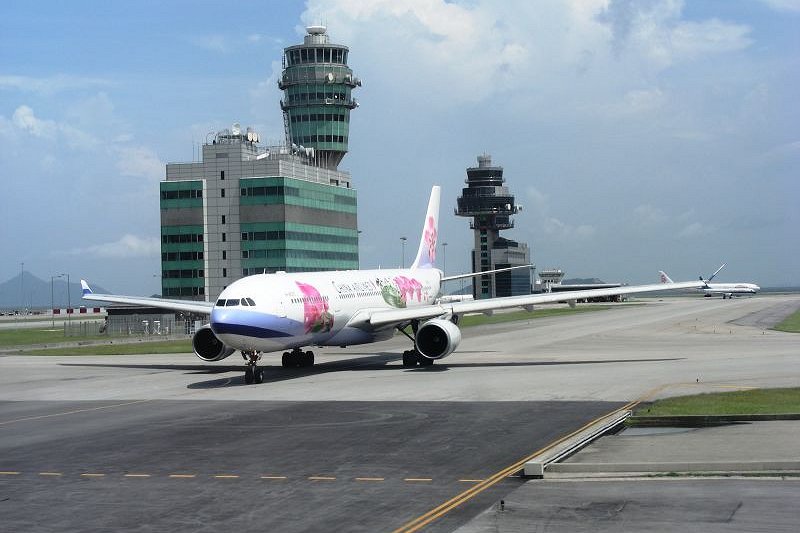 Plane and control tower at the Plane and control tower at the Hong Kong International Airport
Plane and control tower at the Plane and control tower at the Hong Kong International AirportSource: http://commons.wikimedia.org/wiki/File:Hong_Kong_International_Airport_(526352478).jpg
Author: Thierry

Airport Layout
View Hong Kong International Airport in a larger map
Arriving at Hong Kong International Airport
Arrival CardMake sure you have completed the arrival card for clearing immigration. It has probably been passed to you on board your flight. Otherwise, there are arrival cards at Arrivals.
Customs
Goods prohibited from entering Hong Kong include meat products, fish, rice and ozone-depleting substances. Travelers over the age of 18 are allowed to bring in 1 liter of alcoholic liquor with an alcoholic strength above 30% when measured at 20°C, and either 19 cigarettes or 1 cigar or 25g of cigars or 25g of any other tobacco product.
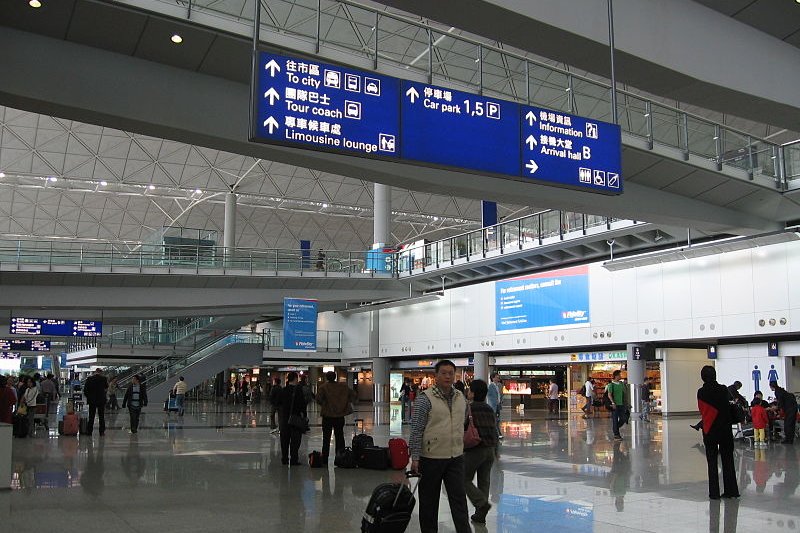 Arrival Hall, Hong Kong International Airport
Arrival Hall, Hong Kong International AirportSource: http://commons.wikimedia.org/wiki/File:Hong_Kong_International_Airport,_Arrival_Hall_5,_Mar_06.JPG
Author: Sengkang
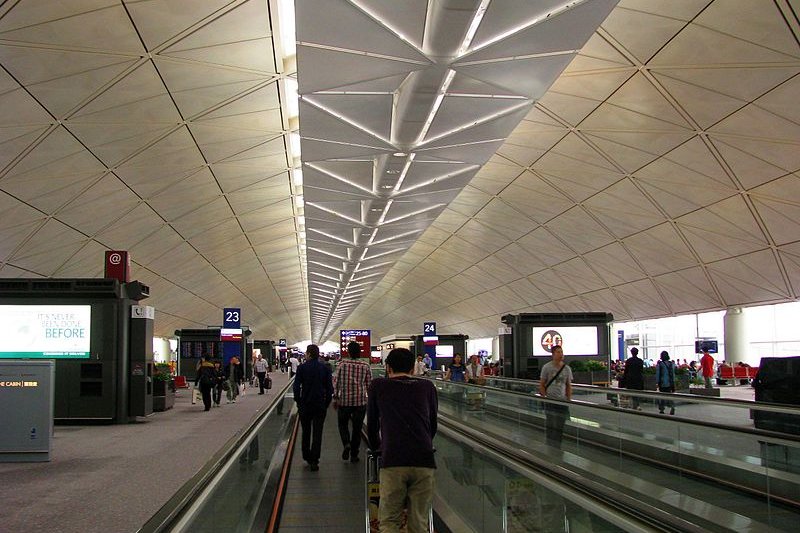 Walkway, Terminal 1, Hong Kong International Airport
Walkway, Terminal 1, Hong Kong International AirportSource: http://commons.wikimedia.org/wiki/File:Hong_Kong_International_Airport_Terminal_1_-10.jpg
Author: Aimaimyi

View Layout of Hong Kong International Airport in a larger map.
Layout of Hong Kong International Airport
The airport comprises Terminal 1 (T1) and Terminal 2 (T2), and the Ground Transportation Centre between them. All flights arrive and depart from Terminal 1, which until 2007, was the sole terminal of the airport.
T2, located to the west of the Ground Transportation Centre, began operations on 28 February 2007. It has check-in facilities used by a number of low-cost airlines, though all departure gates are at T1. Also occupying T2 is the SkyPlaza, a huge shopping area.
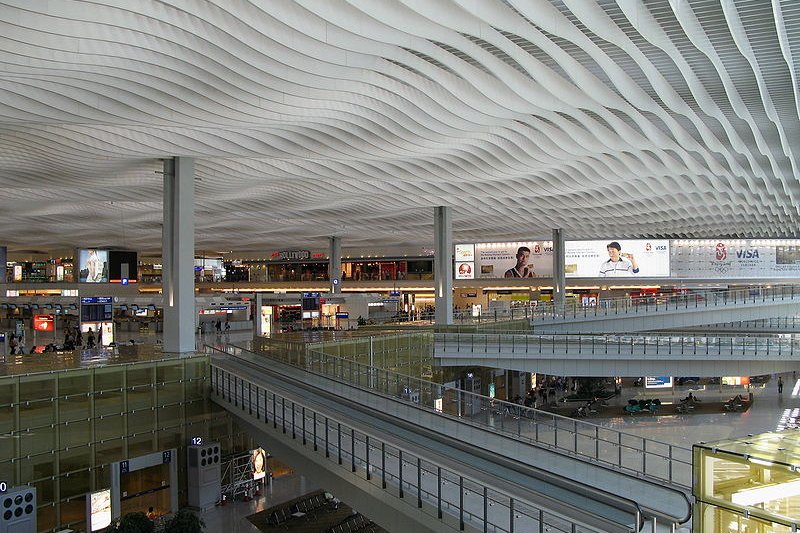 Skyplaza, Terminal 2
Skyplaza, Terminal 2Source: http://commons.wikimedia.org/wiki/File:HK_Skyplazaview_20070709.jpg
Author: WiNG

In addition to T1 and T2, there is a detached North Satellite Concourse (NSC). It opened in December 2009 to increase percentage of passengers boarding via aerobridges to 90%. The NSC has 10 aerobridges. As it is not linked to the main terminal building, passengers arriving or departing from here are ferried by shuttle bus to and from T1 every four minutes.
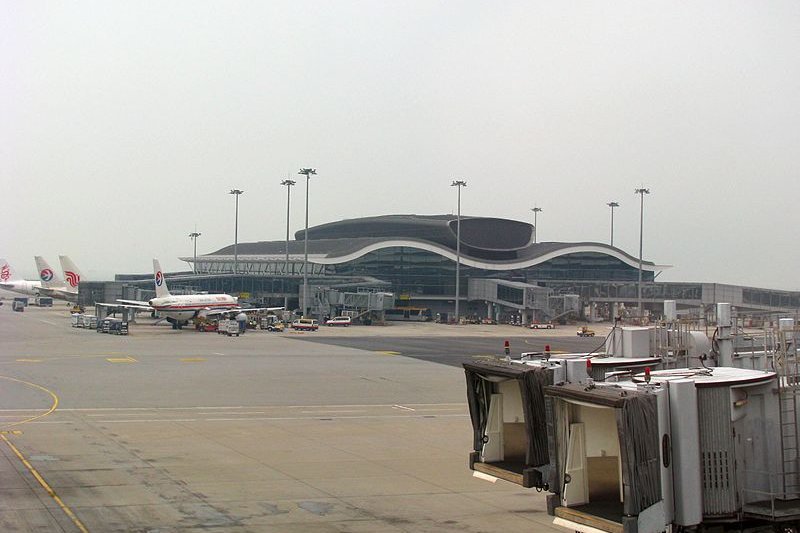 North Satellite Concourse, Hong Kong International Airport
North Satellite Concourse, Hong Kong International AirportSource: http://commons.wikimedia.org/wiki/File:Hong_Kong_International_Airport_North_Satellite_-01.jpg
Author: Aimaimyi

Getting around the Hong Kong International Airport
A driverless transport called the Automated People Mover connects various parts of the airport such as Terminals 1 and 2 as well as the SkyPier Ferry Terminal.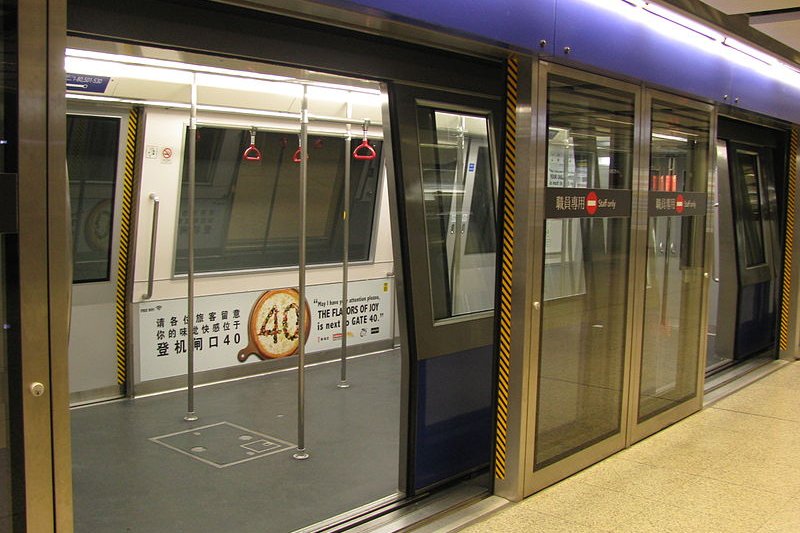 Automated People Mover at the Hong Kong International Airport
Automated People Mover at the Hong Kong International AirportSource: http://commons.wikimedia.org/wiki/File:Hong_Kong_International_Airport_APM_-01.jpg
Author: Aimaimyi

Getting out of Hong Kong International Airport
Your options for exiting the airport by public transport include the Airport Express, Hotel Coaches, the Airport Shuttle Bus, Taxi and rental car. Airport Express is the high-speed train of the Mass Transit Railway (MTR) connecting the airport with downtown.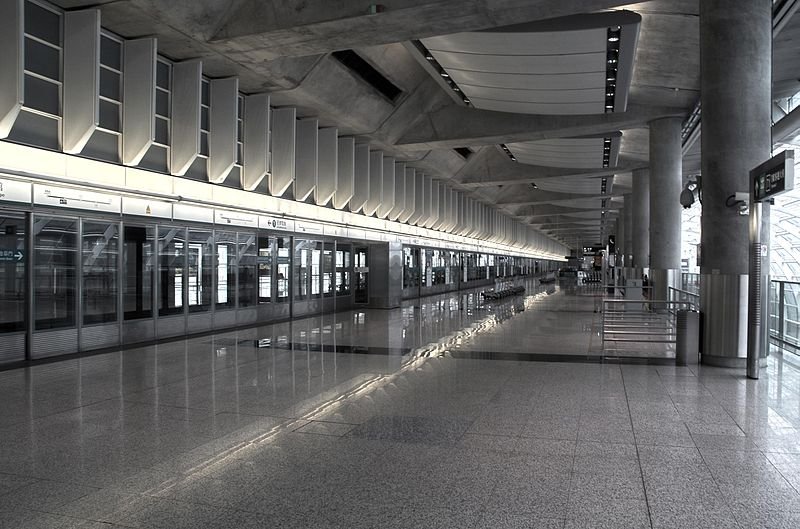 Platform 1, Airport Station, Hong Kong MTR
Platform 1, Airport Station, Hong Kong MTRSource: http://commons.wikimedia.org/wiki/File:AirPlat1_1.jpg
Author: Devilreborn

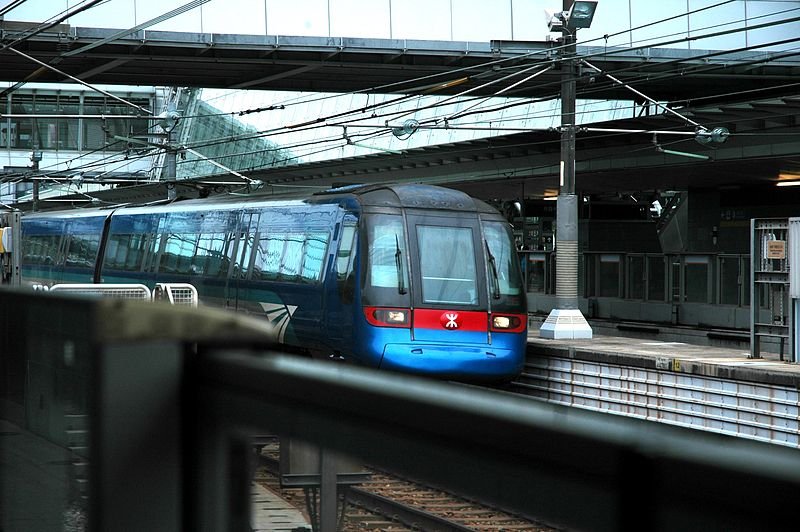 Airport Express MTR
Airport Express MTRSource: http://commons.wikimedia.org/wiki/File:AtrainAelSun1.jpg
Author: Devilreborn

Hotel Coaches transport you to major hotels in Hong Kong. Buy your ticket at Counter C15 at Terminal 2. The deluxe coaches run every 15 minutes from 6:00 am in the morning until 1:00 am the following morning. After buying your ticket, wait for the next coach at the Coach Station.
Taxis line up at the taxi stand with is down the ramp to the left of the Arrival Hall exit. Follow the Taxi sign. You will see taxis of different colors in different aisles. The red taxis cover urban areas of Hong Kong (which is everywhere except Tung Chung Road and places in south Lantau), the green ones cover New Territories, and the blue ones cover Lantau. A ride to downtown Hong Kong will cost between HK$250 to HK$350, depending on traffic condition. For approximate fares to your destination, check the chart at the taxi stand. The taxis must abide by meter, which is HK$20 for the first 2 kilometers, followed by HK$1.50 for every subsequent 200 meters until a fare of HK$72.50, after which the fare is HK$1.00 for every subsequent 200 meters.
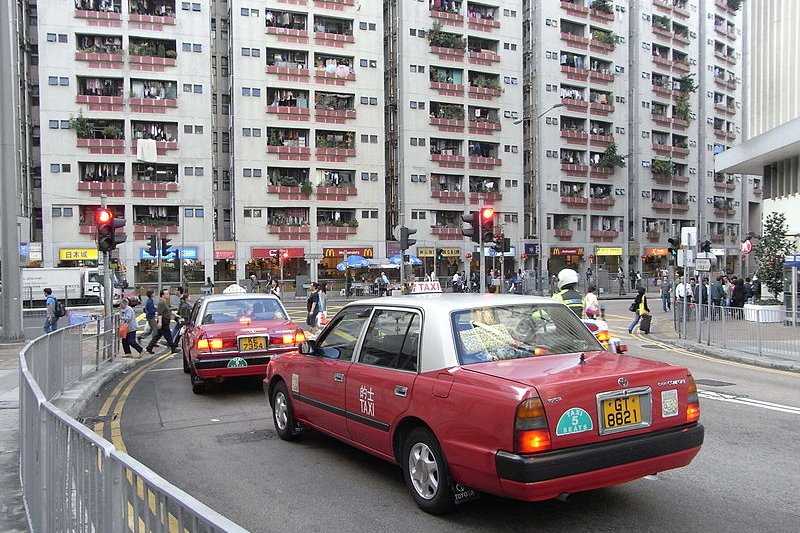 Hong Kong urban taxi
Hong Kong urban taxiSource: http://commons.wikimedia.org/wiki/File:HK_Hung_Hom_%E5%AE%B6%E7%B6%AD%E9%82%A8_Ka_Wai_Estate_%E9%A6%AC%E9%A0%AD%E5%9C%8D%E9%81%93_facade_%E5%A4%A7%E7%92%B0%E9%81%93_Tai_Wan_Road_Taxi.jpg
Author: Resiwuhoo

Public buses can be taken from the bus stop which is down the ramp to the right of the Arrival Hall exit. There are many buses but the most suitable for tourists are the A routes, which offers you scenic views out of the airport.
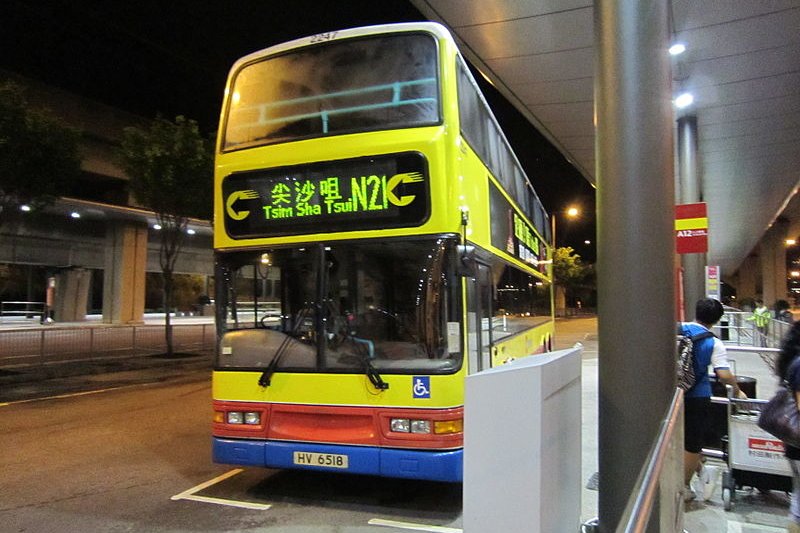 Bus N31 at the Ground Transportation Centre of the Hong Kong International Airport
Bus N31 at the Ground Transportation Centre of the Hong Kong International AirportSource: http://commons.wikimedia.org/wiki/File:N21_HV_6518.JPG
Author: 圍棋一級

Departing from Hong Kong International Airport
Transportation to Hong Kong International Airport is the same as with arrivals, namely the Airport Express, Hotel Coaches, Taxis and Public Buses.There are check-in desks at both Terminal 1 and 2. The two terminals are connected by walkway. It takes just two minutes to walk between them.
Hand-carry baggage must not exceed 56 cm x 36 cm x 23 cm.
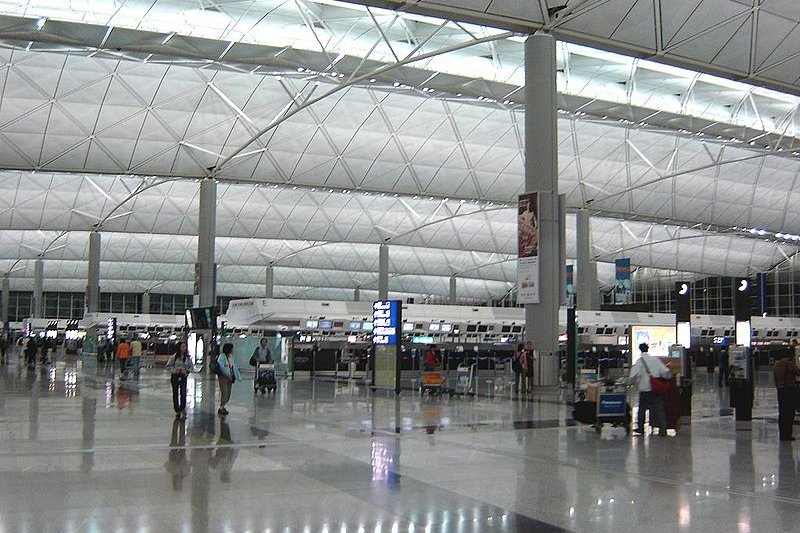 Check-in counters at Terminal 1
Check-in counters at Terminal 1Source: http://en.wikipedia.org/wiki/File:Hong_Kong_Airport_Inside.JPG
Author: Siqbal

Facilities at Hong Kong International Airport
SkyPier is a cross-boundary ferry terminal that began operations in 2009. There are two airport hotels and a golf course, the SkyCity Nine Eagles Golf Course within the airport.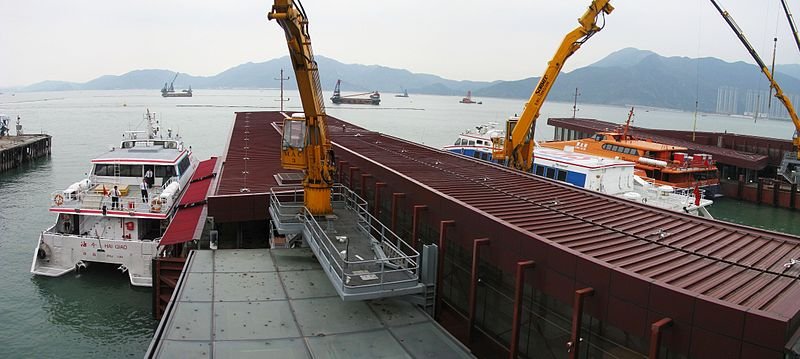 Skypier, Hong Kong International Airport
Skypier, Hong Kong International AirportSource: http://commons.wikimedia.org/wiki/File:SkyPier_-01.jpg
Author: Aimaimyi

Information on Hong Kong International Airport
Airlines using Terminal 1Aeroflot, Air Canada, Air China, Air France, Air India, Air Mauritius, Air New Zealand, Air Niugini, All Nippon Airways, Asiana Airlines, Biman Bangladesh Airlines, British Airways, Cathay Pacific Airways, Cebu Pacific Air, China Airlines, China Eastern Airlines, China Southern Airlines, Delta Air Lines, Dragonair, EL AL Israel Airlines, EVA Airways, Emirates Airline, Ethiopian Airlines, Finnair, Garuda Indonesia, Hong Kong Airlines, Hong Kong Express, Japan Airlines, KLM Royal Dutch Airlines, Kenya Airways, Korean Air, Lufthansa German Airlines, Malaysia Airlines, Mandarin Airlines, Mega Maldives, Nepal Airlines, Orient Thai, Pakistan International Airlines, Qantas Airways, Qatar Airways, Royal Brunei Airlines, Swiss International Air Lines, Shanghai Airlines, Sichuan Airlines, Singapore Airlines, SriLankan Airlines, Transaero Airlines, Turkish Airlines, United Airlines, Vietnam Airlines, Virgin Atlantic Airways and Xiamen Airlines.
Airlines using Terminal 2
Air Astana, Air Busan, Air Pacific, AirAsia, Airphil Express, Bangkok Airways, City Airways, Jeju Air, Jet Airways, Jetstar, Jin Air, Jeneyao Airlines, MIAT Mongolian Airlines, Mongolian Airlines Group, Palau Airways, Peach Aviation, Royal Jordanian, S7 Airlines, Shenzhen Airlines, South African Airways, South East Asian Airlines, Spring Airlines, Thai Airways, Tianjin Airlines, Tiger Airways and Vladivostok Air.
 Latest updates on Penang Travel Tips
Latest updates on Penang Travel Tips
 Discover with Timothy YouTube Channel
Discover with Timothy YouTube Channel
 PG Food Channel
PG Food Channel
 Learn Penang Hokkien YouTube Channel
Learn Penang Hokkien YouTube Channel
 SojiMart Videos
SojiMart Videos
 Share your travels and/or ask a travel-related question
Share your travels and/or ask a travel-related question
Join the Penang Travel Tips Facebook Group to share photos, tips and anything related to your travels, or ask travel-related questions.
 Map of Roads in Penang
Map of Roads in Penang
Looking for information on Penang? Use this Map of Roads in Penang to zoom in on information about Penang, brought to you road by road. Discover with Timothy
Discover with Timothy
Let me take you to explore and discover Penang through my series of walking tours on YouTube. You may use these videos as your virtual tour guide. At the beginning of each video, I provide the starting point coordinates which you may key into your GPS, Google Maps or Waze, to be navigated to where I start the walk, and use the video as your virtual tour guide.Disclaimer
Please use the information on this page as guidance only. The author endeavours to update the information on this page from time to time, but regrets any inaccuracies if there be any.Latest from Discover with Timothy: Gurney Bay - what to see and do there
About this website

Hello and thanks for reading this page. My name is Timothy and my hobby is in describing places so that I can share the information with the general public. My website has become the go to site for a lot of people including students, teachers, journalists, etc. whenever they seek information on places, particularly those in Malaysia and Singapore. I have been doing this since 5 January 2003, for over twenty years already. You can read about me at Discover Timothy. By now I have compiled information on thousands of places, mostly in Peninsular Malaysia and Singapore, and I continue to add more almost every day. My goal is to describe every street in every town in Malaysia and Singapore.
Robbie's Roadmap
- Episode 1: Robbie's Journey to Financial Freedom
- Episode 2: Lost in America
- Episode 3: The Value of Money
- Episode 4: The Mentor
- Episode 5: The Thing that Makes Money
- Episode 6: The walk with a Billionaire
- Episode 7: The Financial Freedom Awakening
- Episode 8: Meet Mr Washington
- Episode 9: The Pizzeria Incident
Copyright © 2003-2024 Timothy Tye. All Rights Reserved.


 Go Back
Go Back